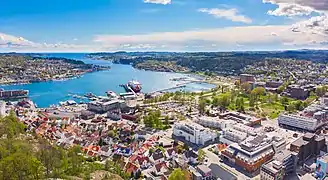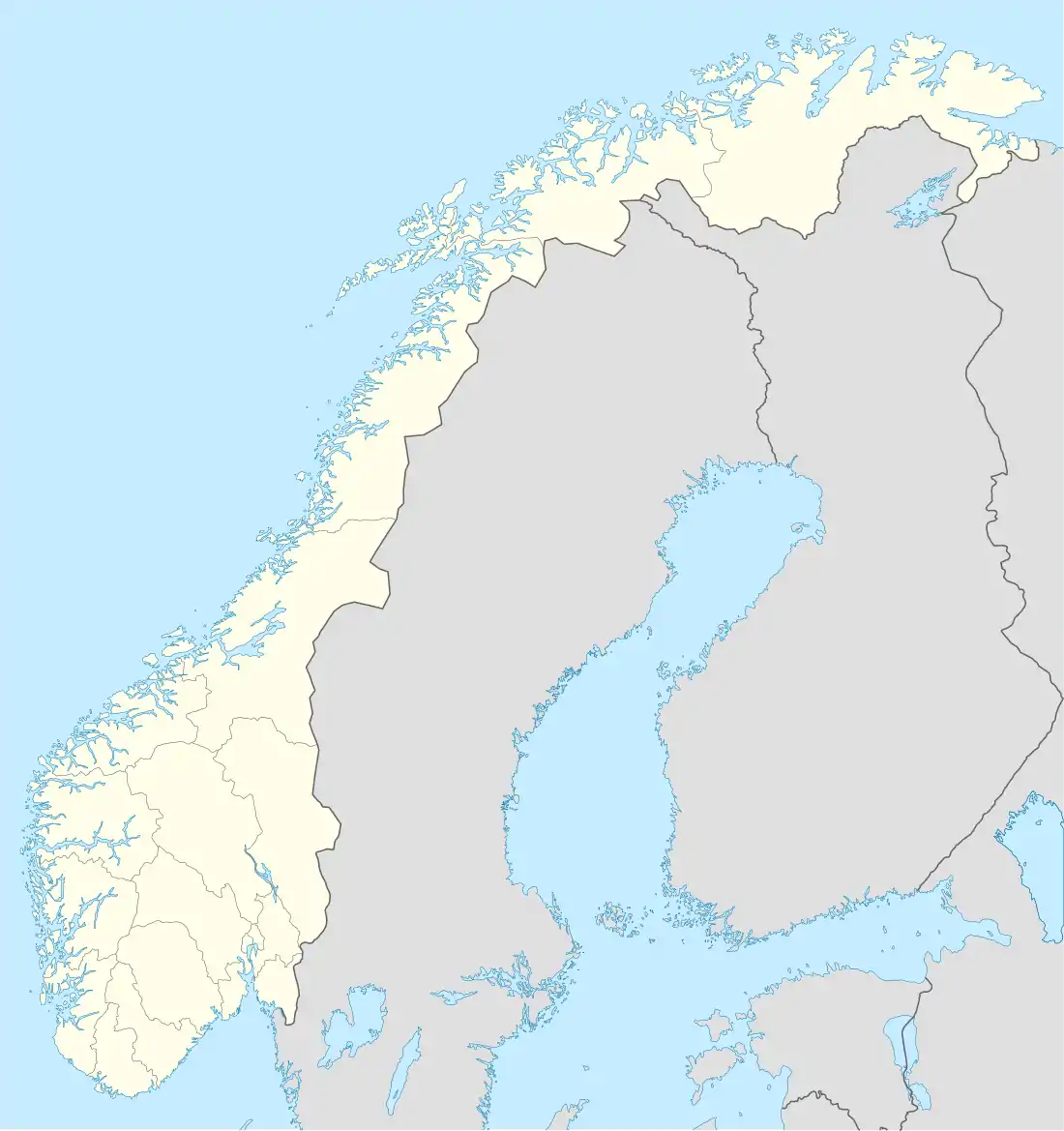Sandefjord | |
|---|---|
 View of the town | |
| Nickname(s): Hvalfangstbyen ("The Whaling City"), Badebyen ("The Bathing City") | |
 Sandefjord Location of the town  Sandefjord Sandefjord (Norway) | |
| Coordinates: 59°07′53″N 10°13′20″E / 59.13133°N 10.22234°E | |
| Country | Norway |
| Region | Eastern Norway |
| County | Vestfold |
| District | Vestfold |
| Municipality | Sandefjord Municipality |
| Established as | |
| Ladested | 1680 |
| Kjøpstad | 1845 |
| Area | |
| • Total | 24.19 km2 (9.34 sq mi) |
| Elevation | 5 m (16 ft) |
| Population (2022)[2] | |
| • Total | 45,816 |
| • Density | 1,894/km2 (4,910/sq mi) |
| Demonym | Sandefjording |
| Time zone | UTC+01:00 (CET) |
| • Summer (DST) | UTC+02:00 (CEST) |
| Post Code | 3210 Sandefjord |
Sandefjord (Norwegian pronunciation: [ˈsɑ̂nːəfjuːr] ⓘ) is a city (or town)[1] that is the administrative centre of the large Sandefjord Municipality in Vestfold county, Norway. The town is located at the head of the Sandefjordsfjorden, along the Skaggerak coast in southern Vestfold. The large town also includes coastal areas on both sides of the Mefjorden on the Vesterøya and Østerøya peninsulas. The 24.19-square-kilometre (5,980-acre) town has a population (2022) of 45,816 and a population density of 1,894 inhabitants per square kilometre (4,910/sq mi).[2]
The city is known for its rich Viking history and the prosperous whaling industry, which made Sandefjord the richest city in Norway.[4] Today, it has built up the third-largest merchant fleet in Norway.[5] The Sandefjord Museum is located in the town, the only museum in Europe that is dedicated to whaling. The 9th-century Gokstad Ship was discovered at the nearby Gokstad Mound, on the eastern edge of the city.
The Church of Norway has several churches in the city of Sandefjord including Sandefjord Church, Sandar Church, Bugården Church, and Vesterøy Church.
Sandefjord has numerous nicknames, including the Viking "capital" of Norway. It is also known as the undisputed summer city of Norway.[6][7] The city is also known as the "whaling capital of the world" or the "whaling capital of Norway".[8][9][10][11] It has also been dubbed the "Bathing City" (Badebyen), due to its many beaches and former resort spas.[10] It is still considered a resort town, due to high numbers of visitors during summer months.[12]
History
Sandefjord has been inhabited for thousands of years.[13]: 6 Excavations indicate that people have inhabited Sandefjord for around 3,000 years. Rock carvings at Haugen farm by Istrehågan in Jåberg are dated to 1,500–500 BCE.[14]
The Vikings lived in Sandefjord and surrounding areas about 1,000 years ago, and numerous Viking artifacts and monuments can be found in Sandefjord.[15] One of the most important remains from the Viking Age was found at the grave site Gokstadhaugen (Gokstad Mound) in Sandefjord. The Gokstad ship was excavated by Nicolay Nicolaysen and is now in the Viking Ship Museum in Oslo.
The town of Sandefjord was established as a ladested in 1680, giving it rights as a seaport. On 1 January 1838, it was established as a self-governing municipality under the new formannskapsdistrikt law. Sandefjord functioned as a seaport defined by the twin industries of shipping and shipbuilding throughout the 1600s and 1700s. It was formally recognized as a market town (kjøpstad) by King Oscar in 1845
Over time, the city-municipality was enlarged. On 1 January 1889, a part of the neighboring municipality of Sandeherred (population: 318) was transferred into Sandefjord. In 1931, an area of the neighboring municipality of Sandar (population: 66) was transferred into Sandefjord. In 1950, another area of the neighboring municipality of Sandar (population: 226) was transferred into Sandefjord. During the 1960s, there were many municipal mergers across Norway due to the work of the Schei Committee. On 1 January 1968 the city-municipality of Sandefjord (population: 6,242) was merged into the surrounding municipality of Sandar (population: 24,898), creating a much larger municipality which was also named Sandefjord. Prior to the merger, the city and municipality were one and the same, but after the merger, the city was just one small part of a much larger municipality.[16]
Etymology
The name Sandefjord was first mentioned in chapter 169 of Sverris saga from the year 1200. It was then referring to the fjord which is now known as Sandefjordsfjord.[17]: 353 The municipality (originally the city of Sandefjord) is named after the local fjord, now called Sandefjordsfjorden since the city of Sandefjord grew up at the head of the fjord. The first element of the name comes from the old Sande farm (Old Norse: Sandar). The old farm name is the plural form of sandr which means "sand" or "sandbanks". The last element comes from the word fjǫrðr which means "fjord".[18][13]: 6 [19]
Gallery
See also
References
- 1 2 In the Norwegian language, the word by can be translated as "town" or "city".
- 1 2 3 Statistisk sentralbyrå (1 January 2022). "Urban settlements. Population and area, by municipality".
- ↑ "Sandefjord, Sandefjord". yr.no. Retrieved 2 December 2023.
- ↑ Porter, Darwin; Prince, Danforth (2003). Frommer's Norway. Wiley. p. 158. ISBN 9780764524677.
- ↑ "Things to Do in Sandefjord – Frommer's". Frommers.com. Retrieved 28 December 2017.
- ↑ "Three shot in Sandefjord". Newsinenglish.no. 14 January 2011. Retrieved 28 December 2017.
- ↑ "The Viking trail through Vestfold, Norway" (PDF). Destinationviking.no. Retrieved 28 December 2017.
- ↑ Engel, Lyle Kenyon (1963). Scandinavia: A Simon & Schuster Travel Guide. Cornerstone Library. p. 145.
- ↑ Ryder, Simon; Duffy, Cameron (2018). Insight Guides Norway. Insight Guides. p. 163. ISBN 9781786717580.
- 1 2 Alspaugh, Emmanuelle (2006). Fodor's Norway. Fodor's Travel Publications. pp. F-7 and 73. ISBN 9781400016143.
- ↑ Bertelsen, Hans Kristian (1985). Sandefjord: A modern city with vast potential. Grafisk Studio. p. 81. ISBN 8290636008.
- ↑ Berman, Martha (1995). Fielding's Scandinavia. Fielding Worldwide. p. 240. ISBN 9781569520499.
- 1 2 Sandberg, Tore; Arveschoug, Cato (2001). Sandefjord zoomet inn av fotograf Tore Sandberg (in Norwegian). C. Arveschoug and Magne Helland. ISBN 9788299616706.
- ↑ "Sandefjord". Gonorway.no. Archived from the original on 19 June 2018. Retrieved 28 December 2017.
- ↑ "Sandefjord – In the footsteps of the Vikings". Visitnorway.com. Retrieved 28 December 2017.
- ↑ Jukvam, Dag (1999). "Historisk oversikt over endringer i kommune- og fylkesinndelingen" (PDF) (in Norwegian). Statistisk sentralbyrå. ISBN 9788253746845.
- ↑ Davidsen, Roger (2008). Et Sted i Sandefjord (in Norwegian). Sandefjord, Norge: Sandar Historielag. ISBN 9788299456753.
- ↑ Rygh, Oluf (1907). Norske gaardnavne: Jarlsberg og Larviks amt (in Norwegian) (6 ed.). Kristiania, Norge: W. C. Fabritius & sønners bogtrikkeri. p. 260.
- ↑ Aadnevik, Kjell-Einar (2019). Turguide til Larvik og Omegn (in Norwegian). Dreyers forlag. p. 135. ISBN 9788282654418.


.jpg.webp)



